The growth of cities, the rapid development of industry, the intensification of agriculture, the improvement of the cultural and living conditions of people and a number of other factors have led to the pollution of water resources.
This is especially the case in densely populated areas, cities where there are large traffic flows, large and small markets are located, there are many gas stations and other enterprises [1].
The purpose of this work is to study the pollution of the water of the Chui Valley rivers: Ala-Archa, Alamedin, BCHK with heavy metals.
Lead, mercury, cadmium were taken from heavy metals.
Water is a valuable human product, because our body consists of 60-70 % water. Water is present in all tissues of our body. For example: brain contains 70 %, heart 75 %, lungs 85 %, liver 86 %, kidneys 83 %, muscles 75 %, blood 83 %. Therefore, the lack of water is difficult for the body to tolerate. Dehydration contributes to the development of many diseases [2].
The purpose of this work is to study the pollution of the water of the Chui Valley rivers: Ala-Archa, Alamedin, Big Chui river with heavy metals. Lead, mercury, cadmium were taken from heavy metals. Water is very necessary product for human because our body consists of 60-70 % water. There is present in all parts of body. For example: brain contains 70 %, heart 75 %, lungs 85 %, liver 86 %, kidneys 83 %, muscles 75 %, blood 83 %. Therefore, the lack of water brings difficulty for the body to tolerate. Dehydration contributes to the development of many diseases [1].
The danger of lead for humans is that it is highly toxic and can accumulate in the body. Lead gets in to the human body with food (40-70 %), drinking water, dust from contaminated soils, etc. Lead enters the environment, that is, soil, water, atmosphere with salts of inorganic acids (lead chloride, lead sulphate) from transport, where highly toxic alkylated compounds tetraethyl lead, tetramethyl lead are used, from lead paints, batteries
Mercury kills the nervous system of humans and other animals. When exposed to mercury on the human body, memory gets worse (Alzheimer’s disease), and we get anxiety and self-doubt, irritability and headaches, bleeding gums, heart disease, urination problems, etc [3].
Mercury comes to the environment from mercury lamps, medical waste, also from industry (vinyl chloride, etc.), mercury batteries.
Cadmium is dangerous with its any form. A dose of 30-40 mg is lethal. When cadmium enters the body, it damages the kidneys and the nervous system, disrupts the functions of the genitals, and causes acute bone pain in the back and legs. In addition, cadmium causes impairment of lung function and has a carcinogenic effect, accumulates in the kidneys, and people get poisoning.
Cadmium is easily absorbed by plants from the soil, also we can find it in tobacco leaves, and therefore tobacco smoke has a high cadmium content.
Excessive intake of cadmium into the body will bring anemia, pulmonary emphysema, osteoporosis, hypertension, can damage liver, etc [4].
To determine the content of the above heavy metals, we have chosen a spectrometric method using an AAS-7000 atomic absorption spectrometer.
The essence of this method is in the resonant absorption of electromagnetic (visible) radiation of a certain wavelength through a layer of atomic vapors of the element being determined [5].
Sampling for chemical analysis is carried out in accordance with GOST 17.1.5.05-85. Water is taken in containers with a volume of 500 ml, 1 liter from a polymer material, which should not enter into a reaction with the sample, so as not to change the composition of the water.
Samples were taken from the waters of the Ala-Archa, Alamedin rivers and from the water of the Big Chui river. Samples were taken from each of these waters at three locations. From the Ala-Archa river, near the Osh market and in the village of Maevka.
From the Alamedin River – to the villages of Kok-Zhar, Tash-Moinok and Alamedin. From Big Chui river – railway station Ak-Bosogo, in the village of Gidrostroitel and near the Alamedin market.
The experimentation data came out from the spectrometric analysis of the water of the Ala-Archa, Alamedin and big chui rivers are given in tables 1, 2, 3. Using these datas of these tables, we have constructed diagrams 1, 2, 3 and gradient-level plots 1, 2, 3.
Table 1 shows the experimental data obtained in the study of the water of the Ala-Archa River.
To compare the content of heavy metals in water, the tables give the maximum concentration.
Table 1 shows that the lead content at all points does not exceed the Maximum concentration, on the contrary, it is 5 times lower than A-Ar-1; 1.42 times lower than A-Ar-2; 2 times lower at point A-Ar-3.
Table 1
The content of heavy metals in the water of the Ala-Archa river
|
№ |
Heavy metals |
Sample points |
Unit of measurement |
Maximum permissible concentration |
||
|
A-Ar-1 |
A-Ar-2 |
A-Ar-3 |
||||
|
1 |
Pb 283,3 |
0.002 |
0.007 |
0.005 |
mg/dm3 |
0.01 mg/dm3 |
|
2 |
Hg 253,3 |
0.001 |
0.005 |
0.003 |
mg/dm3 |
0.005 mg/dm3 |
|
3 |
Cd 228,8 |
0.005 |
0.003 |
0.002 |
mg/dm3 |
0.003 mg/dm3 |
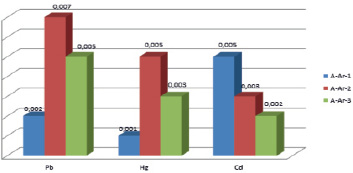
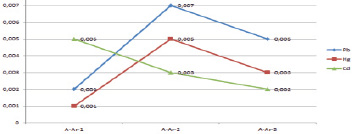
Fig. 1. Diagram and calibration graph of the content of heavy metals in the water of the Ala-Archa river
Mercury at points 1 and 3 is less than the maximun concentration, at point 2 it is equal to the MC.
Cadmium A-Ar-1 is 1.66 times more, at the second point it corresponds to the MC, at the third point it is 1.34 times lower than the norm.
Using the data in Table 1, we built diagrams and calibration graphs.
Experimental data on the study of the water of the Alamedin River, we showed in table 2, in diagram 2 and calibration graph 2.
As we can see from Table 2, the lead content of the Alamedin River at all three points exceeds the MPC 200 times. In our opinion, this is due to the fact that the Alamedin River flows in those places where there are large traffic flows, densely populated areas, and many different enterprises.
Table 2
Content of heavy metals in the Alamedin River
|
№ |
Heavy metals |
Sample points |
Unit of measurement |
Maximum permissible concentration |
||
|
Ala-1 |
Ala-2 |
Ala-3 |
||||
|
1 |
Pb 283.3 |
2.28 |
2.17 |
2.21 |
mg/dm3 |
0.01 mg/dm3 |
|
2 |
Hg 2530000.3 |
0.001 |
0.005 |
0.003 |
mg/dm3 |
0.005 mg/dm3 |
|
3 |
Cd 228.3 |
0.18 |
0.15 |
0.13 |
mg/dm3 |
0.003 mg/dm3 |
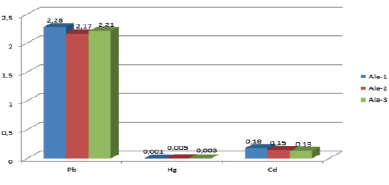
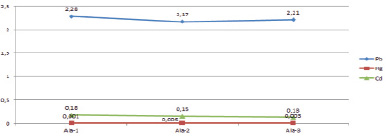
Fig. 2. Diagram and calibration graph of the content of heavy metals in the water of the Alamedin River
Mercury in the Alamedin River is contained below the MPC, and at the Ala-2 point it corresponds to the maximum permissible concentration, below the norm.
Cadmium at all three points exceeds the maximum permissible concentration by about 6 times. The data on the determination of heavy metals in the water of the Big Chui River we presented in table 3.
Table 3
The content of heavy metals in the water of the Big chui river
|
№ |
Heavy metals |
Sample points |
Unit of measurement |
Maximum permissible concentration |
||
|
ВСНК-1 |
ВСНК-2 |
ВСНК-3 |
||||
|
1 |
Pb 283.3 |
2.32 |
2.29 |
2.26 |
mg/dm3 |
0.01 mg/dm3 |
|
2 |
Hg 253.3 |
0.003 |
0.005 |
0.001 |
mg/dm3 |
0.005 mg/dm3 |
|
3 |
Cd 228.8 |
0.23 |
0.17 |
0.19 |
mg/dm3 |
0.003 mg/dm3 |
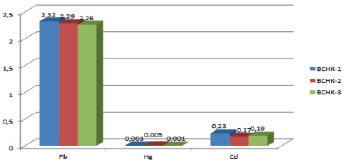

Fig. 3. Diagram and calibration graph of the content of heavy metals in the water of the Big chui river
In the water of the Big chui river, a high content of lead is seen at all points and it is 232; 229; 226 times higher than MPC.
On the contrary, mercury does not exceed at points 1 and 3, at the second point the content of mercury is equal to the MPC.
Cadmium, like lead, is contained in all three points above the maximum permissible concentration. At the first point the maximum concentration limit is 76 times higher. At the second and third points, it exceeds the maximum permissible concentration by 63 times. This is explained by the fact that the Big chui river flows through agricultural fields where farmers grow tobacco.
As mentioned above, cadmium is found most of all in tobacco and tobacco smoke. Using the data in Table 3, diagram 3 and calibration curve 3 are constructed.
Thus, we have determined the content of heavy metals (Pb, Hg, Cd) in the waters of the Ala-Archa, Alamedin and Big chui rivers, which flow through the city of Bishkek. As we expected, the dense population of the city, a large flow and resulting traffic jams, the discharge of untreated industrial and domestic wastewater and many other reasons will lead to water pollution in the Ala-Archa, Alamedin and Big chui rivers.
The use of a universal, accurate, modern atomic absorption method made it possible to determine the trace amount of these heavy metals in the water of these rivers.

